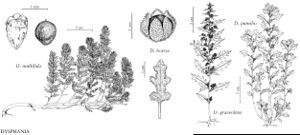Dysphania botrys
Ukrayins’k. Bot. Zhurn., n. s. 59: 383. 2002.
Stems erect to ascending, branched at base to ± simple, 1–6(–10) dm, pubescent with short-stalked glandular hairs. Leaves aromatic; petiole to 2.5 mm; blade 1.3–4 × 0.6–2.7 cm, base cuneate, margins lyrate-sinuate, pinnatifid, or occasionally entire (in distal leaves), apex acute to subobtuse, glandular-pubescent abaxially. Inflorescences axillary cymes, often arranged in terminal thyrses, 12–24 cm, subtended by cauline leaves; bracts absent. Flowers: perianth segments 5, distinct nearly to base, distinct portion elliptic or ovate to oblong, 0.7–1.1 × 0.5–0.7 mm, apex acute to obtuse, rounded abaxially, densely glandular-pubescent, covering fruit at maturity; stamens 1–3(–5); stigmas 2. Achenes subglobose; pericarp adherent, membranaceous, papillose, becoming rugose, usually white-blotchy. Seeds globose to subglobose, (0.5–) 0.6–0.8 × 0.5–0.7 mm, margins rounded (rarely indistinctly furrowed); seed coat rugose. 2n = 18.
Phenology: Fruiting Aug–Oct.
Habitat: Sandy or gravelly soils, dry rocky ridges and cliffs, mud flats, waste places
Elevation: 0-2000 m
Distribution

Introduced; B.C., N.B., N.S., Ont., P.E.I., Que., Ariz., Calif., Colo., Conn., Del., Idaho, Ill., Ind., Iowa, Kans., Ky., La., Maine, Md., Mass., Mich., Minn., Mo., Mont., Nebr., Nev., N.H., N.J., N.Mex., N.Y., N.C., N.Dak., Ohio, Oreg., Pa., R.I., S.Dak., Tex., Utah, Vt., Va., Wash., W.Va., Wis., Wyo., s Europe, s, c, se Asia.
Discussion
Dysphania botrys is related to a species from Africa and southern Eurasia, D. schraderiana (Schultes) Mosyakin & Clemants, which may occur locally in North America as introduced. Dysphania schraderiana has distinctly keeled perianth segments with mostly sessile or subsessile glands. The general inflorescence in D. schraderiana is usually leafy almost to the top, distal cauline leaves are similar to proximal ones (in D. botrys distal leaves are normally much reduced, and the distal portion of the general inflorescence appears nearly leafless). H. A. Wahl (1954) reported that D. schraderiana (as Chenopodium schraderianum) had been grown in Ontario. He did not indicate that it had escaped.
Selected References
None.
